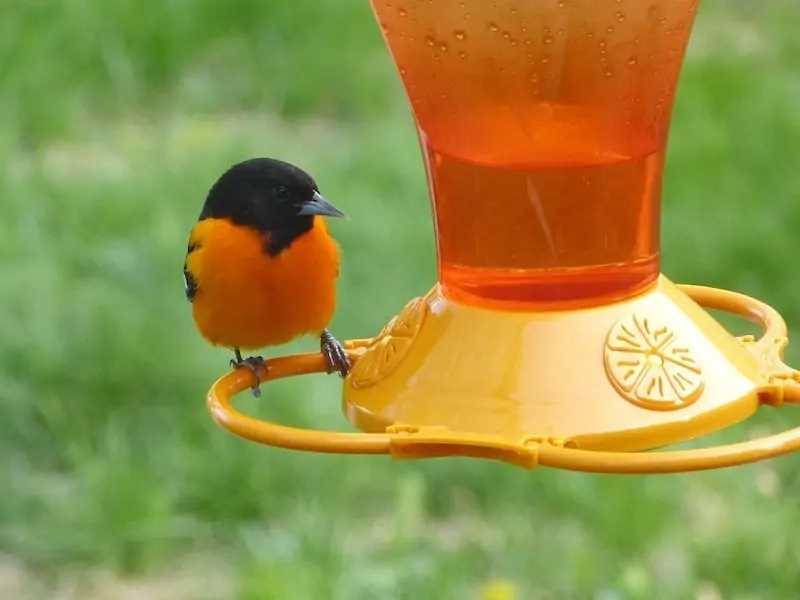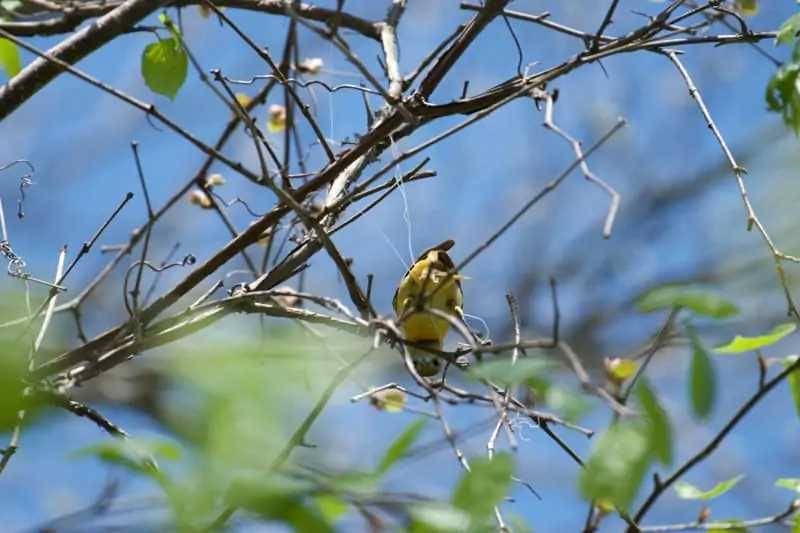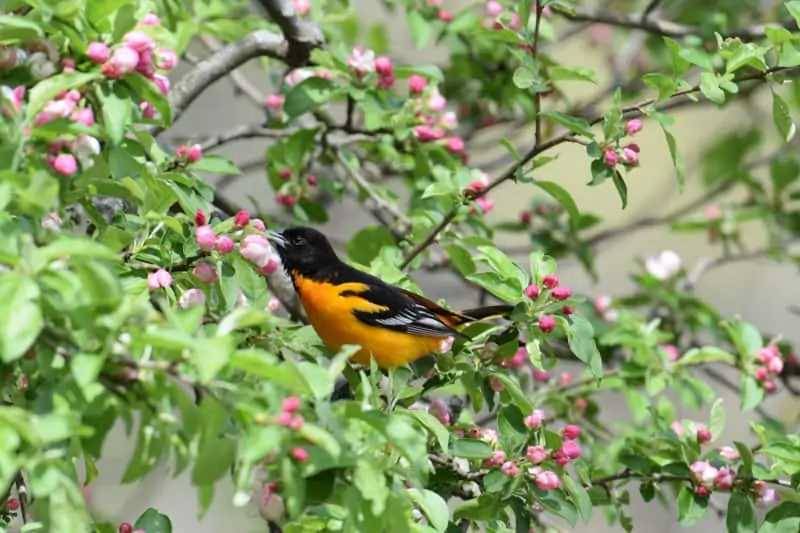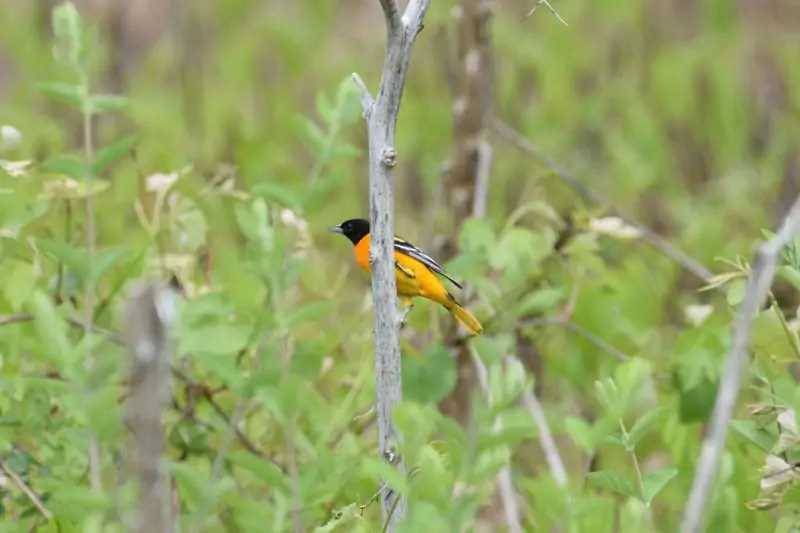

Probably the best thing you can do to attract Orioles is to offer them the sugary foods they love in the springtime. The most popular foods to leave out to attract orioles to your backyard are grape jelly, oranges, and nectar.
Grape jelly: feed smooth grape jelly in a small dish, only leave out as much as can be eaten in a day and put out fresh jelly each day. This avoids spoiling and bacteria growth. Look for no sugar added and organic jelly when possible. Even healthier for the birds, chop up some grapes and offer those! Oranges: cut an orange in half, simple as that! Hang it from a pole, or even impale it on nearby tree branches.Most oriole feeders have pegs for offering oranges and small cups for offering the jelly. is one of our favorites for orioles. See our article on

Orioles are migratory. They spend their winters down in central and south America, then travel back into the U.S. and Canada in the early spring and stay through the summer to have their young. It is important that you put out any oriole-specific food 2-3 weeks BEFORE you expect to see them. While orioles will use certain backyard bird feeders, they aren’t a common backyard bird and much prefer to find natural sources of food. You want them to notice your food as soon as they arrive back from migration.
You can use the recorded sightings from pages such as and to look more closely at your area to see when people report their first orioles. However you can use these dates as a general guideline:
Baltimore Oriole and Orchard Oriole: these orioles of the eastern United States will appear first in the southern states of Texas, Louisiana, Georgia and Alabama as early as the end of February but definitely by March.This brings us to our next point.

The feeder has to be easily visible from the treetops. Orioles spend most of their time up in the high treetops (mainly deciduous trees) and will need to be able to see your food from up there.
Put oriole feeders in a nice open spot in your yard they can spot while flying over. Don’t hide them too close to the house or underneath a heavy canopy of tree branches. Orioles are attracted to bright colors that indicate fruit or flowers. Many manufacturers will color oriole feeders bright orange to take advantage of this fact. A bright orange feeder will send out a beacon to any orioles nearby to come and investigate.
After the orioles have reached their final destination and chosen their breeding ground, they switch up their food. By late spring / early summer, they are getting nests ready and raising their young. During this period they need more protein and nutrients in their diet and will consume more insects than fruit (although fruit does remain part of their diet). If you managed to attract some orioles offering the sugary spring foods, switch over to more protein filled offerings in the late spring. are a great choice. Orioles will also occasionally eat .
So you put out some oranges, and were enjoying watching the orioles come to your yard daily.
Orioles much prefer natural food sources, and are less inclined to visit backyard feeders once nature starts to provide what they need. By the end of spring flowers have bloomed and nectar is available.
However, if an oriole builds a nest in a tree near your property, you have a much higher likelihood of them returning for food throughout the season. It’s all about proximity of food to their nest.

Orioles don’t nest in tree cavities or bird houses, nor do their nests look like what you typically think of when you think of a birds nest. Instead, the female orioles weave a hanging basket that is sometimes described as “sock-like”.
These nests hang high in tall trees, usually from the ends of thin, delicate branches that won’t support the weight of larger birds that may pose a threat to her eggs, like crows and hawks. They also do most of their food foraging in the treetops looking for insects and fruits.
If possible make the oriole feeding station separate from your other bird feeders. Orioles are a little on the shy side and might not feel comfortable venturing too close to a feeder full of loud and rambunctious songbirds. The best would be an open spot (visibility) close to shrubs and other cover that they can retreat to if they feel threatened. However if this is not possible don’t worry about it.

Orioles are fruit eaters and will be more likely to visit your yard if you have fruiting trees and shrubs. Planting some food bearing trees and shrubs can help attract orioles and many other species of birds to your yard. As always, be sure to check that what you plant is native to your region. For orioles consider blackberries, raspberries, huckleberry, elderberry, mulberry, wild cherry and dogwood.
Orioles also enjoy nectar, so brightly colored flowers (especially orange) that produce nectar are a good choice. Some examples are trumpet honeysuckle, trumpet vine, cardinal flower, columbine, salvias, jewelweeds and bee balm.
As we mentioned above, once the insect population increases in the late spring the orioles consume them as a large part of their diet. They will also be feeding their young mainly insects. While you are less likely to see them hopping on your lawn looking for bugs, they will be visiting your trees and shrubs. Be cautious when spraying any vegetation in your yard with pesticides or other treatments.
As always, a supply of clean water will attract many kinds of birds. Orioles are no exception and need water for bathing and drinking. They are larger birds and would do better with a bath that had a . Water wigglers, fountains, and drippers will help create that attractive sound of moving water that birds look for.

Whether you are lucky enough to have orioles nearby for the whole summer season, or only get a quick glimpse in the spring, they are a real treat to behold. Few birds that we come into contact with on a regular basis have such vibrant colors and songs. Good luck and happy birding!